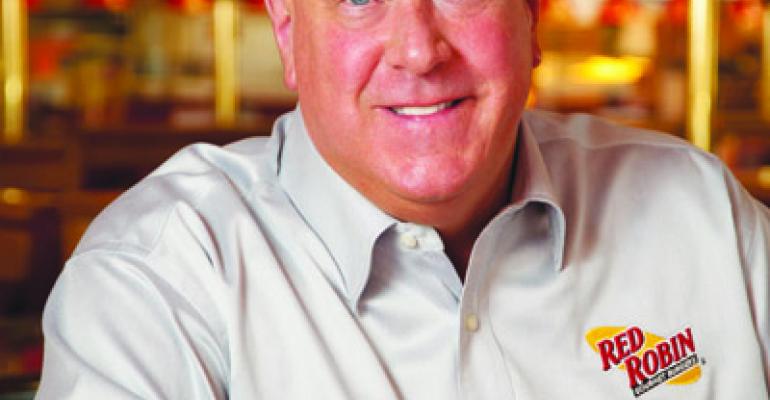Rounding out his second year as chief executive at Red Robin Gourmet Burgers, Steve Carley said efforts to revitalize the casual-dining chain are taking hold.
RELATED
• Red Robin continues turnaround efforts
• Red Robin to open fast-casual Burger Works
• More full-service restaurant news
Known for its two-handed burgers and bottomless fries, Red Robin has been hit by growth in the fast-casual segment as “better burger” players like Five Guys Burgers and Fries and Smashburger expand.
With a multi-point turnaround plan dubbed Project RED — which stands for revenue growth, expense management and deployment of capital — Red Robin has cut costs, upgraded its menu, built up its bar business and launched a new loyalty program that has more than a million members.
Most recently, Red Robin has beefed up its culinary team and, in January, the chain opened a state-of-the-art test kitchen and consumer-learning lab, where training videos can also be filmed.
Earlier this year, Red Robin also launched a new Tavern Double platform with innovative burgers that start at $6.99, but have check-building add-on options for $1 more.
Traffic counts have been declining, however, and Carley said new initiatives will focus on driving guests through the door.
In an interview with Nation’s Restaurant News Friday, Carley outlined things to come for Red Robin:
It sounds like you’re gearing up for more work on the menu. Can you tell us what’s planned?
When I first came on board, it had come to a point where we didn’t even have alcohol or dessert menus on the table anymore. It was more important to turn the table than giving guests a chance to get dessert or a milkshake or another beer. The first thing I did was put menus on the tables, and we put in a happy hour and expanded our appetizer menu. Then we began to build our dessert menu.
We’re in early innings of all of that. Now we’re making a real effort around appetizers, especially ones for parties of two — now all are shareable for four or more. We’ll do more desserts, like individual indulgences that people can share or take with them. We’re looking at things like cake pops and samplers of different milkshakes, or stuff that’s shareable so you don’t have to commit to a big slice of pie, and prices that are flexible to add on to a check.
Our new mixologist has taken a new look at our beverage lineup, so you’ll see more there.
You have been building the bar business. How is that going?
Ten years ago we were doing about 11 percent beverage/alcohol sales. Over the next decade, that dropped to almost 6 percent. The great news is that in 2011, we added 70 basis points to beverage/alcohol and 90 basis points in the first quarter.
You have been taking a lot lately about value. How is Red Robin communicating that message to consumers?
We did more consumer research last year than we’ve ever done. We wanted to see where we were winning and where we were losing. What came back is that we have overwhelming brand equity with families and kids, and if you’re looking for a high-energy casual environment. The challenge is all-around value and affordability. Consumers said, ‘We want Red Robin, but we need more value and affordability.’
We think the new Tavern platform offers that. It’s a third-pound of beef, with American cheese, lettuce, tomato, mayo on a toasted bun, and then we have things like Buffalo style with blue cheese and shaved celery, and you can add that for only $1.
Continued from page 1
Starting Monday we’re doing a new Cry Baby style with sautéed onions, onion straws and fiery ghost peppers with fresh and dried jalapeno crumbs. We’re thinking of having people sign a waiver before ordering it.
But we’re looking at a platform that has everyday value for lunch or happy hour, late night or for smaller appetites. At $6.99 with bottomless fries and $2.49 for a soda, it’s just over $10, and that compares with Five Guys.
Are fast-casual burger concepts your competition, even more than casual-dining players?
We want to reassert our authority as the gourmet burger place. I think most of the fast-casual guys are coming at us with burgers. We, of all the casual diners, need to be mindful of protecting that platform, particularly at lunch.
What are your plans for growing the Burger Works concept?
Our third Burger Works is open and we’re really pleased with the top line so far. In July, we open one in Boulder, Colo., where we have a 20-year-old, full-size Red Robin closing because the lease was up, but we’re relocating the Burger Works to the other side of the parking lot. It’ll be 3,000 square feet, so that will be a great test.
We’re doing five-minute tickets out of Burger Works. It also has the Tavern burger starting at $4.99, and there’s a category called Build Your Own, which is one of the more popular. We have milkshakes and we’ll do hand-breaded chicken tenders.
We’ll open five by year’s end, then we’ll assess where we are. We are thinking next year we’ll do five or 10 more. We’ll do 12 to 15 full-size Red Robins next year. So total, we’re targeting about 25 big and small Red Robins, which is up from this year’s total of about 13.
What’s your view of how consumers are feeling now?
I’m seeing consumers looking a lot like they’ve looked for the past year and a half or so. People have frugality fatigue. They like to get out and give themselves permission to do that, but then they hear the constant drumbeat of bad news, unemployment, debt, and they go back in their bunkers. They’re skittish and nervous.
Contact Lisa Jennings at [email protected].
Follow her on Twitter: @livetodineout





